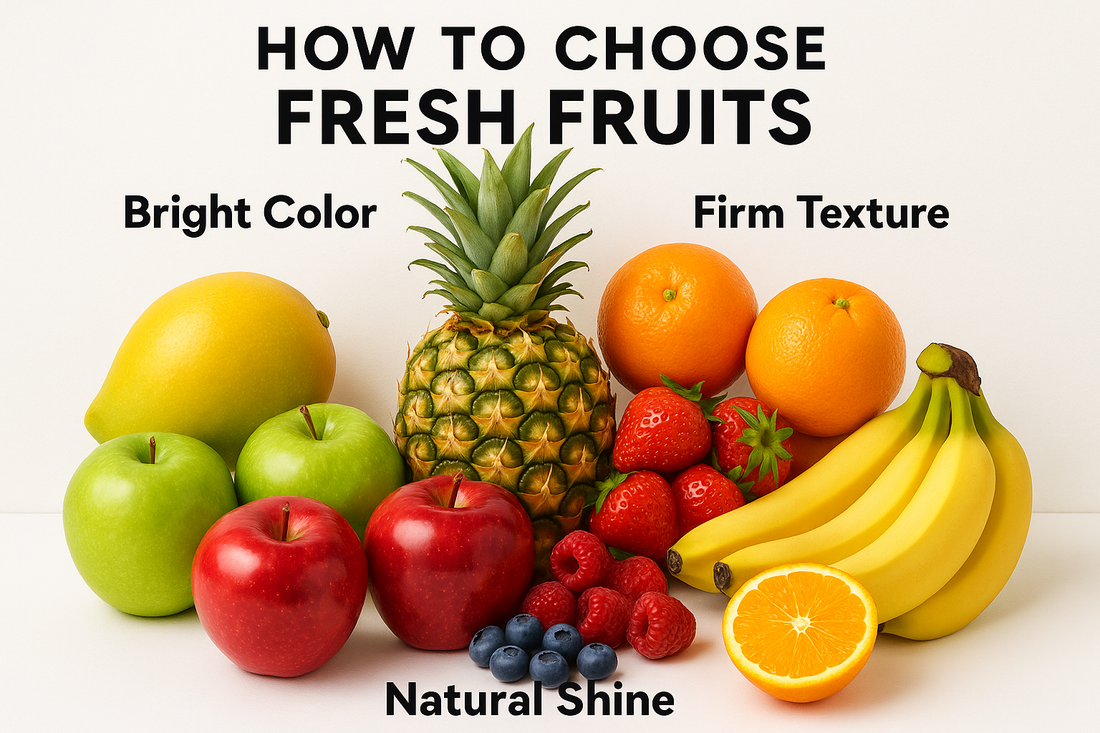
How to Choose the Freshest Fruits Every Time: Expert Selection Guide
Share
Selecting the freshest fruits at the market or grocery store is an essential skill that ensures you get the best flavor, nutrition, and value for your money. Whether you're shopping for apples, mangoes, oranges, or pomegranates, knowing what to look for can make all the difference!
Why Freshness Matters
Fresh fruits not only taste better but also contain higher levels of vitamins, minerals, and antioxidants. They last longer in your kitchen, reducing waste and saving money. Plus, fresh fruits have better texture and aroma, making them more enjoyable to eat.
Universal Signs of Fresh Fruit
Before we dive into specific fruits, here are general indicators that apply to most fruits:
- Firmness: Fresh fruits should feel firm but give slightly when pressed gently
- Weight: Heavier fruits typically contain more juice and are fresher
- Aroma: Fresh fruits have a pleasant, sweet smell, especially near the stem
- Color: Look for vibrant, consistent coloring without dull patches
- Skin: Smooth, unblemished skin without bruises, soft spots, or wrinkles
- No mold: Check carefully for any signs of mold or decay
How to Choose Specific Fruits
Apples
Look for: Firm texture with smooth, shiny skin. The color should be vibrant and appropriate for the variety (red for Red Delicious, green for Granny Smith, etc.).
Avoid: Soft spots, bruises, wrinkled skin, or mealy texture. Press gently—if it feels mushy, it's past its prime.
Pro tip: Smaller apples often have more concentrated flavor. Check the stem end—it should be firmly attached.
Mangoes
Look for: Slight give when pressed gently, sweet aroma near the stem, and smooth skin. Color varies by variety, so don't judge ripeness by color alone!
Avoid: Very soft or mushy texture, fermented smell, black spots, or shriveled skin.
Pro tip: Ripe mangoes should smell sweet and tropical. If there's no aroma, they're not ripe yet. You can ripen them at home in a paper bag.
Oranges and Citrus
Look for: Heavy for their size (indicates juiciness), firm texture, and bright color. The skin should be smooth and slightly glossy.
Avoid: Light weight (means dry inside), soft spots, mold, or overly rough, thick skin.
Pro tip: Small blemishes on the skin don't affect the inside. Choose oranges that feel heavy—they're the juiciest!
Pomegranates (Anar)
Look for: Heavy for their size, deep color (red or pink depending on variety), and angular shape. The skin should be firm and leathery.
Avoid: Light weight, soft spots, cracks, or brown patches.
Pro tip: The heavier the pomegranate, the juicier it is. Slight cracks are actually a sign of ripeness, but avoid deep cracks that expose the arils.
Grapes
Look for: Plump, firmly attached to stems, and consistent color. They should have a slight whitish bloom (natural protective coating).
Avoid: Wrinkled grapes, brown stems, or grapes falling off the bunch easily.
Pro tip: Taste one grape from the bunch—if it's sweet, the whole bunch will be. Grapes don't ripen after picking.
Bananas
Look for: Firm texture with bright yellow color (or green if you want them to ripen at home). Small brown spots indicate peak ripeness.
Avoid: Completely brown or black bananas (unless for baking), split skin, or mushy texture.
Pro tip: Buy bananas at different ripeness stages so they don't all ripen at once. Green-tipped bananas will ripen in 2-3 days.
Watermelon
Look for: Heavy for its size, yellow spot on the bottom (where it sat on the ground), and a hollow sound when tapped.
Avoid: White or green bottom spot, very light weight, or dull appearance.
Pro tip: The yellow field spot should be creamy or buttery yellow, not white. This indicates it ripened on the vine.
Shopping Tips for Maximum Freshness
1. Shop Seasonally
Fruits in season are fresher, tastier, and more affordable. Mangoes in summer, apples in winter—follow nature's calendar!
2. Buy Local When Possible
Local fruits travel shorter distances, meaning they're picked riper and arrive fresher. Visit farmers' markets for the best selection.
3. Don't Buy in Bulk Unless You'll Use It
While bulk buying saves money, it's only worthwhile if you can consume or properly store the fruits before they spoil.
4. Check the Bottom of Containers
When buying pre-packaged fruits like berries or grapes, check the bottom of the container for mold, juice, or damaged fruit.
5. Ask Questions
Don't hesitate to ask produce staff when fruits arrived, which varieties are sweetest, or when the next shipment is coming.
6. Use Your Senses
Touch, smell, and look carefully. Your senses are the best tools for selecting fresh produce.
Storage Tips to Maintain Freshness
Once you've selected the freshest fruits, proper storage is key:
- Refrigerate: Apples, grapes, berries, cut fruits
- Room temperature: Bananas, unripe mangoes, citrus (short-term), whole pomegranates
- Ripen then refrigerate: Mangoes, avocados, stone fruits
- Keep separate: Store ethylene-producing fruits (apples, bananas) away from sensitive ones
Common Mistakes to Avoid
- Judging by appearance alone: Sometimes the prettiest fruit isn't the freshest or tastiest
- Buying too far in advance: Buy fruits closer to when you'll eat them
- Ignoring seasonal availability: Out-of-season fruits are often less fresh and more expensive
- Not checking for damage: Always inspect fruits carefully before purchasing
- Assuming organic means fresher: Organic is about growing methods, not necessarily freshness
When to Buy Ripe vs. Unripe
Buy ripe if: You plan to eat within 1-2 days
Buy unripe if: You're shopping for the week ahead
Many fruits like mangoes, bananas, and avocados ripen beautifully at home, giving you flexibility in meal planning.
The Bottom Line
Choosing fresh fruits is part science, part experience. The more you practice, the better you'll become at selecting the best produce. Trust your senses, follow these guidelines, and don't be afraid to ask questions!
Want the freshest fruits delivered to your door? Shop our carefully selected, premium quality fruits today!
